Oman’s telecoms sector has come alive, with a number of licensing processes following fast after each other, which will result in the market becoming one of the most competitive in the Gulf. Things are also afoot at the incumbent operators, Omantel and Nawras, making the atmosphere in the telecoms sector crackle with anticipation.

The announcement of the process to award Oman’s second fixed licence has attracted much domestic interest, though its international appeal is yet to be tested
Between 2005 and 2007, Omantel’s subscriber base grew 14 per cent year-on-year, while revenues grew 16 per cent to US$950 million at the end of 2007. EBITDA grew 21 per cent year-on-year to US$502 million at the end of the same period, while net income grew by 29 per cent to US$293 million.
For the period to the end of June Omantel reported that first half net profit had soared by 54.3 per cent year-on-year to OMR 74.8 million (US$194 million), attributable to growth both mobile and broadband services. The total number of subscribers crossed the two million mark – across mobile, fixed and Internet networks, counting 1.6 million mobile subscribers, 279,000 fixed line users and 112,000 Internet subscribers.
Thus overall mobile penetration in Oman stood at approximately 85 per cent at the end of June, while fixed-line penetration represented less than 10 per cent of the sultanate’s 3.3 million residents.
Omantel forecast that earnings and revenue growth is likely to continue in the second half of the year in view of the strong economic fundamentals in the country, though the looming threat of increased competition is likely to place revenues and earnings under some pressure in the medium term.
Already, the performance of second mobile operator Nawras is impacting significantly on Omantel’s mobile unit, Oman Mobile.
Oman Mobile’s dominant market share continues to dwindle as Nawras expands its own subscriber base. At the beginning of the year Oman Mobile’s market share was estimated at around 60 per cent, but by the mid-point of this year that share had been eroded to 57 per cent, with Nawras’ 43 per cent share representing somewhere in the region of 1.2 million.
Aggressive campaigns from both players have seen a flurry of new services and promotions burst onto the scene during the course of the year, with Oman Mobile having introduced three BlackBerry packages in July aimed at various subscriber segments.
Nawras has introduced an SMS translation service, and in December introduced 3G+ video calling offers. Nawras also now offers discounted welcome packs for new customers and has introduced e-billing, creating a product that enables the e-transfer of credit to SIM cards. The launch of global tracking over GSM has allowed Nawras to win contracts including those for resorts and taxis, helping the operator make more of
an impression on the business sector.
Omantel privatisation
Omantel’s stock price has been buoyed in recent weeks as the government announced plans to sell a 25 per cent stake in the telco to a strategic partner.
At the beginning of July, Oman’s ministry of finance announced bidders interested in the stake would need to submit expressions of interest by July 18.
The partial sale of the Omani incumbent, 100 per cent of which is valued at US$4.4 billion (as of July 2, 2008), is expected to be completed during the fourth quarter of this year. This transaction will reduce the government’s shareholding in the telco from 70 per cent to 45 per cent.
Ministry of finance secretary general, Darwish Ismail Al Bulushi, said: “The Omani telecoms market still has excellent growth potential and Oman offers an attractive economic environment that we are certain will appeal to bidders”.
Al Bulushi said the government may also consider providing the selected strategic investor with, “certain rights enabling it to increase its economic and voting exposure to Omantel in the future”.
Interested telcos had to satisfy the following prequalification criteria before submitting an expression of interest:
- Be able to provide sufficient expertise as an integrated telecoms operator to substantially contribute to the management and growth of Omantel, both organically and via international expansion
- Have substantial experience in operating fixed-line and mobile services
- Have an operational presence in multiple countries
- Provide telecoms services to a minimum of five million active subscribers, including a minimum of two million active subscribers in a single market
- Financial capacity that meets certain stated minimum criteria on capitalisation, assets and revenues
- The interested party (or consortium) must also retain its stake in Omantel for at least five years
UAE-based provider Etisalat said last October it was considering acquiring a stake in Omantel, though it is Saudi Telecom (STC) that has emerged as an early frontrunner for the stake.
At the end of July, STC confirmed its interest in acquiring the stake on offer, despite having been a late entrant to overseas expansion. And such is the interest in the stake in Omantel that only last month Qatar Telecom (Qtel) deemed it necessary to issue a statement categorically denying media reports linking the telco with a bid for the 25 per cent stake.
The Qatar incumbent stated that it has not expressed an interest in bidding for this stake, clarifying that as the majority shareholder in Nawras, Qtel is mindful of the Omani rules and regulations.
Nawras
Having launched in March 2005, the Nawras subscriber base is currently growing faster than ever, according to the mobile operator’s passionate CEO, Ross Cormack. He believes the operator has gained the credibility of offering a wide range of services, while maintaining its mission of being caring, excellent and pleasingly different.
“When we launched 3G+ in December, 20 per cent of handsets on the network at that time were already 3G-enabled,” Cormack states. “For many, it was their first ever access to the Internet and the network extends to 25 per cent of the population, while we have 94 per cent coverage of the population with the rest of our service,” Cormack adds.

Nawras’ operational success, having succeeded in garnering over 40 per cent market share, representing more than 1.25 million subscribers, is matched by it financial success. The operator became profitable on an EBIT level, last year and is now being closely scrutinised as it moves towards the preparation of an initial public offering.
Ross Cormack says Nawras doubled its customer base last year, with the staff compliment having risen to just under 500
As part of its licensing conditions, Nawras had to agree to list 40 per cent of the operator on the domestic stock exchange by February 2010. According to Cormack, financial advisors have already been retained, and it is now a board decision regarding when the process officially kicks off.
“Going forward, my priorities are continuing to build the brand. We have created a lifestyle brand and the point is to look after employees, who will in turn look after customers, who will ultimately take care of the shareholders,” Cormack comments.
“We still do have certain specific skills that we have to grow, such as pricing and roaming, and we have brought in experienced international people to kick start this process.”
Second fixed line licence
On August 11, the Telecommunications Regulatory Authority (TRA) of Oman announced that telcos and consortiums interested in bidding for a second fixed line licence in the sultanate would be required to submit their bids by August 25.
An auction amongst short-listed bidders and licence award is expected to be completed by late October, with Nawras amongst those to have expressed an early interest in participating in the award process.
The Class 1 fixed-line licence is being offered as a 25-year build-and-operate contract, and a similar 15-year contract for broadband services.
Pre-selection criteria states bidders must have been in operation for more than two years, and have at least 300,000 active fixed subscribers and net assets of US$200 million. Interested parties may be 100 per cent foreign owned with no Omani partner required, however, no association with Omantel is allowed.
Regulatory official, Naashiah Bint Saud Al Kharusi, stated that the provider that plans to invest the most money in the backbone would have the competitive edge in the auction. The successful bidder will have to pay seven per cent of gross revenues to the government as royalty and an upfront fee of OMR500,000 upon selection.
Reseller market
At the end of June the TRA confirmed the issuance of five Class 2 licences in the sultanate, allowing the resale of basic mobile services. Friendi Mobile, through a bidder called Arab Link was awarded one of the five-year licences, together with Injaz International, Kalam Telecommunications, Majan Telecom, and Mazoon Mobile. The cost of each licence is OMR2,500.

Majan Telecom CEO Nielsen says that voice will be a large part of a Renna proposition, though value added services will also be incorporated in the product offering
The reseller licences, which are akin to mobile virtual network operator (MVNO) concessions require a commercial agreement with one of the existing operators, Oman Mobile or Nawras, whereby the licencees are permitted to resell basic mobile services having bought airtime from the network operators in bulk. The services offered by the resellers can then be rebranded and offered to subscribers at local rates.
Resellers have the option of programming and issuing their own branded SIM cards or relying on the host operators to provide their programmed SIMs.
Additionally, the licensees can independently recharge the products and services they distribute or utilise the infrastructure of the host operator. Billing and invoicing may also be independently handled by the licensee or by the host operator.
Market commentators have suggested that not all five resellers are likely to become viable propositions, or may in fact come to market, with room for only three to survive in the Oman telecoms market. Thus all five are understood to be locked in discussions with the incumbents in order to sign a deal first and come to market before the end of this year.
Despite not having confirmed signing a commercial agreement with an operator at the time of going to press, Mohamed bin Yousuf bin Alawi, chairman of Friendi Mobile in Oman said he was confident the licencee’s future services would bring benefits to consumers.
“Because our technology allows us to use the existing networks we will have excellent coverage from day one. This approach will guarantee the quality of coverage, which we believe is the most important factor for any mobile user,” Alawi stated. Friendi Mobile is a Dubai-based start-up that is looking to build a pan-regional MVNO business.

Given the relatively small size of the Omani population and the effective development of telecoms services by the two licensed network operators, there has been some scepticism about the prospects the five resellers face in the market. As a benchmark, it is estimated that attracting a base of at least 100,000 subscribers is necessary in order for a MVNO/reseller to achieve the economies of scale necessary to sustain a viable business.
Niklas Nielsen, CEO of Majan Telecom remains convinced that the Omani market represents a good opportunity for the investment by resellers.
“In terms of the viability of a reseller in Oman, I agree with the overall benchmark figure of 100,000 subscribers as break even point,” Nielsen told Comm. “Of course this benchmark varies from case to case especially with variations in ARPU, subscriber acquisition costs and wholesale rates. And I am quite surprised if anyone would think it is unlikely for a reseller to gain 100,000 subscribers within five years in Oman,” he added.
With a population of a little over three million, Nielsen estimates the size of the addressable market at around two million. “Normally you say that MVNOs are able to reach a combined market share of 20 per cent dependent on the size of market and number of players. This leaves around 300,000 subscribers to the reseller space,” Nielsen said.
However, Nielsen also acknowledged that given the overall benchmark assumptions, with potentially five resellers in Oman, there will be fierce competition.
“Market forces will determine who wins in the longer run – those who add most value to the market and are able to run the leanest operation.”
Majan Telecom plans to operate in Oman under the brand ‘Renna’, which means ‘to ring’ in Arabic. A common Arabic phrase is “abu renna”, which refers to a missed caller, and Nielsen commented that his company’s target market could be identified through this pattern of behaviour of people who leave missed calls in order for the other party to call them back.
Nielsen believes his company has developed a value adding proposition – both in terms of seeing it from the customers’ point of view, and seeing it from the host operator. “Plus we have from the beginning kept our eyes firmly fixed on running a low cost operation perspective. We do not have a lot of expensive overhead, we do not run our operations from high-street offices and we have no got a huge backlog of costs to recoup,” Nielsen explained.
“It would be foolish of me not to say it is important to be one of the first two resellers in the market. If you are not in the first two, perhaps it would be better to delay launch, accept that you are not one of the first, and launch later with something completely unique.”





0 comments ↓
There are no comments yet...Kick things off by filling out the form below.
Leave a Comment